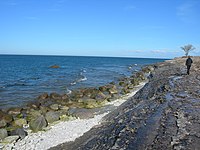Drift (geology)

Drift is a big word that geologists use to talk about all the rocks, dirt, and sand that get moved around by things like glaciers, rivers, and wind. Imagine you have a big bucket of sand and you start moving it around. Some of the sand will go to one side of the bucket, and some of it will go to the other side. This is kind of like how drift works in geology.
Sometimes, glaciers (big, giant sheets of ice) will scrape against the ground and pick up rocks and dirt. Then, they'll carry these things along with them as they move. When the ice melts, the rocks and dirt are left behind, in a big pile, kind of like a dumping a bag of marbles onto the floor. This pile of rocks and dirt that's left behind is called a 'moraine'.
Other times, when it rains really hard, rivers and streams get really full and start to overflow. When this happens, the water can move really quickly and pick up rocks and dirt from the land around it. Then, when the water slows down, it drops these things off in different places. Over time, the river or stream might carve out a valley, with a layer of dirt and rocks on the bottom. This layer is called 'alluvium'.
Finally, sometimes, strong winds can blow small particles of sand or dirt from one place to another. This is kind of like when you blow on your food to cool it down. The wind picks up the particles and carries them along with it. Then, when the wind dies down, the sand or dirt is dropped off somewhere else. Over time, this can cause dunes to form, or sand to pile up in one spot. This is called 'aeolian drift'.
So, in summary, drift in geology is when rocks, dirt, and sand get moved from one place to another by things like glaciers, rivers, and wind. This can happen in different ways, and leave behind different types of rocks and dirt, but it's all part of how the earth changes over time.
Sometimes, glaciers (big, giant sheets of ice) will scrape against the ground and pick up rocks and dirt. Then, they'll carry these things along with them as they move. When the ice melts, the rocks and dirt are left behind, in a big pile, kind of like a dumping a bag of marbles onto the floor. This pile of rocks and dirt that's left behind is called a 'moraine'.
Other times, when it rains really hard, rivers and streams get really full and start to overflow. When this happens, the water can move really quickly and pick up rocks and dirt from the land around it. Then, when the water slows down, it drops these things off in different places. Over time, the river or stream might carve out a valley, with a layer of dirt and rocks on the bottom. This layer is called 'alluvium'.
Finally, sometimes, strong winds can blow small particles of sand or dirt from one place to another. This is kind of like when you blow on your food to cool it down. The wind picks up the particles and carries them along with it. Then, when the wind dies down, the sand or dirt is dropped off somewhere else. Over time, this can cause dunes to form, or sand to pile up in one spot. This is called 'aeolian drift'.
So, in summary, drift in geology is when rocks, dirt, and sand get moved from one place to another by things like glaciers, rivers, and wind. This can happen in different ways, and leave behind different types of rocks and dirt, but it's all part of how the earth changes over time.
Related topics others have asked about:
